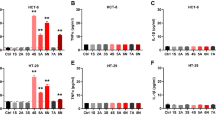Summary
Three sources of fetal bovine serum (FBS) were fractionated by ammonium sulfate precipitation and by sodium dodecyl sulfate-polyacrylamide gel electrophoresis (SDS-PAGE), transferred to Immobilon-P membranes, immunoblotted with a panel of transcription factor antibodies, and detected by enhanced chemiluminescence. Nine transcription factors were detected—ATF-2, SRE-ZBP, GATA-2, TFIID, Ets-1/Ets-2, E2F-1, Oct-2, p53, and AP-2; four transcription factors were not detected—Myo D, CREB, Sp2, and Wilms’ tumor. The results indicated the presence of varying amounts of several transcription factors in three commercial sources and may represent heretofore unrecognized factors influencing cell culture.
Similar content being viewed by others
References
Attar, R. M.; Gilman, M. Z. Expression cloning of a novel zinc finger protein that binds to the c-fos serum response element. Mol. Cell. Biol. 12:2432–2443; 1992.
Baeuerle, P. A. Transcriptional activators. Enter a polypeptide messenger. Nature 373:661–662; 1995.
Bjare, U. Serum-free culture. Pharmacol. Ther. 53:355–374; 1992.
Caamano, J.; Ruggeri, B.; Momiki, S., et al. Detection of p53 in primary lung tumors and nonsmall cell lung carcinoma cell lines. Am. J. Pathol. 139:839–845; 1991.
Dorn, A.; Affolter, M.; Gehring, W. J., et al. Homeodomain proteins in development and therapy. Pharmacol. Ther. 61:155–184; 1994.
Follette, P. J.; O’Farrell, P. H. Connecting cell behavior to patterning: lessons from the cell cycle. Cell 88:309–314; 1997.
Ham, R. G.; McKeehan, W. L. Media and growth requirements. Jakoby, W. B.; Pastan, L. H., ed. Methods in enzymology. Volume 58. San Diego: Academic Press; 1979:43–93.
Harris, C. C.; Hollstein, M. Clinical implications of the p53 tumor-suppressor gene. N. Engl. J. Med. 329:1318–1327; 1993.
Hassapoglidou, S.; Diamandis, E. P.; Sutherland, D. J. Quantification of p53 protein in tumor cell lines, breast tissue extracts and serum with time-resolved immunofluorometry. Oncogene 8:1501–1509; 1993.
He, J.; Furmanski, P. Sequence specificity and transcriptional activation in the binding of lactoferrin to DNA. Nature 373:721–724; 1995.
Hoffman, A.; Sinn, E.; Yamamoto, T., et al. Highly conserved core domain and unique N terminus with presumptive regulatory motifs in a human TATA factor (TFIID). Nature 346:387–390; 1990.
Huber, H. E.; Edwards, G.; Goodhart, P. J., et al. Transcription factor E2F binds DNA as a heterodimer. Proc. Natl. Acad. Sci. USA 90:3525–3529; 1993.
Jayme, D. W.; Blackman, K. E. Culture media for propagation of mammalian cells, viruses, and other biologicals. Adv. Biotechnol. Proc. 5:1–30; 1985.
Kim, S.-J.; Wagner, S.; Liu, F., et al. Retinoblastoma gene product activates expression of the human TGF-beta 2 gene through transcription factor ATF-2. Nature 358:331–334; 1992.
Knepper, P. A.; Mayanil, C. S. K.; Byrne, R. W., et al. Pax 3 transcription factor binds to hyaluronan. Investig. Ophthalmol. Vis. Sci. (Suppl.) 36:S127; 1995.
Knepper, P. A.; Mayanil, C. S. K.; Guzelbag, E., et al. Transcription factors are present in avian yolk and albumin. Dev. Biol. 175:382; 1996.
Lai, J. S.; Herr, W. Ethidium bromide provides a simple tool for identifying genuine DNA-independent protein associations. Proc. Natl. Acad. Sci. USA 89:6958–6962; 1992.
Latchman, D. S. What regulates the regulators. Latchman, D. S., ed. Eukaryotic transcription factors. San Diego: Academic Press; 1995:279–313.
Levine, A. J.; Momand, J.; Finlay, C. A. The p53 tumour suppressor gene. Nature 351:453–456; 1991.
Liu, M.; Dhanwada, K. R.; Birt, D. F., et al. Increase in p53 protein half-life in mouse keratinocytes following UV-B irradiation. Carcinogenesis 15:1809–1892; 1994.
Lukas, R.; Wills, J.; Davis, E., et al. Transcription factors are present in rabbit aqueous fluid. Investig. Ophthalmol. Vis. Sci. (Suppl.) 38:S1128; 1997.
Nicolas, R. H.; Goodwin, G. H. Purification and cloning of transcription factors. Latchman, D. S., ed. Transcription factors, a practical approach. Oxford: IRL Press; 1993:81–104.
Pognonec, P.; Boulukos, K. E.; Gesquiere, J. C., et al. Mitogenic stimulation of thymocytes results in the calcium-dependent phosphorylation of c-ets-1 proteins. EMBO 7:977–983; 1988.
Prochiantz, A.; Theodore, L. Nuclear/growth factors. Bioessays 17:39–44; 1995.
Rana, B.; Mischoulon, D.; Xie, Y., et al. Cell-extracellular matrix interactions can regulate the switch between growth and differentiation in rat hepatocytes: reciprocal expression of C/EBP alpha and immediate-early growth response transcription factors. Mol. Cell. Biol. 14:5858–5869; 1994.
Schmidt, A. M.; Hori, O.; Cao, R., et al. RAGE: a novel cellular receptor for advanced glycation end products. Diabetes 45 Suppl. 3:S77–80; 1996.
Tansey, W. P.; Herr, W. TAFs: guilt by association? Cell 88:729–732; 1997.
Towatari, M.; May, G. E.; Marias, R., et al. Regulation of GATA-2 phosphorylation by mitogen-activated protein kinase and interleukin-3. J. Biol. Chem. 270:4101–4107; 1995.
Williams, T.; Tjian, R. Analysis of the DNA-binding and activation properties of the human transcription factor AP-2. Genes Dev. 5:670–682; 1991.
Wilmut, I.; Schnieke, A. E.; McWhir, J., et al. Viable offspring derived from fetal and adult mammalian cells. Nature 385:810–813; 1997.
Author information
Authors and Affiliations
Rights and permissions
About this article
Cite this article
Knepper, P.A., Mayanil, C.S., Goossens, W. et al. The presence of transcription factors in fetal bovine sera. In Vitro Cell.Dev.Biol.-Animal 34, 170–173 (1998). https://doi.org/10.1007/s11626-998-0101-2
Received:
Accepted:
Issue Date:
DOI: https://doi.org/10.1007/s11626-998-0101-2




